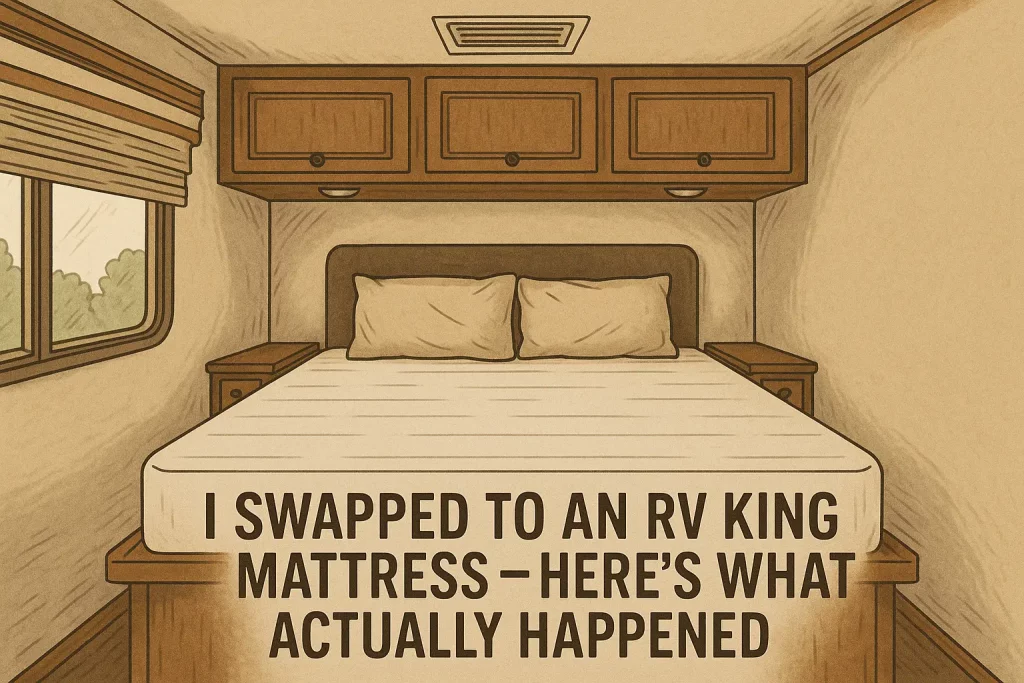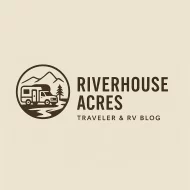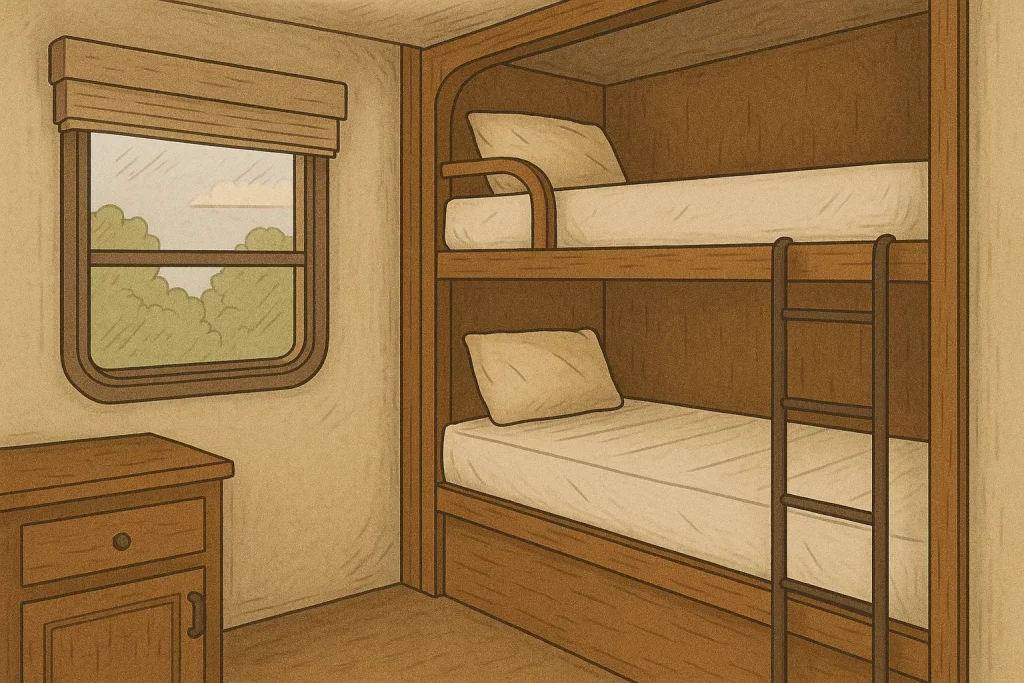
I’m Kayla, and I sleep picky. I’m also a road girl. We camp at least two weekends a month when the weather plays nice. The stock mattress in our fifth wheel felt like a cracker. So I changed it out for an RV king. You know what? I finally slept.
If you’d like the detailed, step-by-step story of the swap itself, you can read my full write-up right here.
The quick version
- Better sleep than the factory pad. Way better.
- Cool enough most nights, warm in heavy heat.
- Great for motion control. Edge support is just okay.
- Fit matters. Measure twice. Then measure again.
What I bought and why
Our rig is a 34-foot fifth wheel with a slide bedroom. The bed space is 72 by 80 inches, which is RV king size. I went with the DreamFoam Essential by Brooklyn Bedding, 10-inch, medium-firm, RV king (72×80). I paid about $499 on sale.
The deep-dive DreamFoam Essential mattress review from Sleepopolis gave me the confidence I wasn’t tossing money at foam hype.
Why that one? Foam for pressure relief. Not too tall, so it clears the cabinets. Boxed, so we could snake it through the door without cussing all day. Well, we still cussed a little. Buying a mattress online can feel a bit like online dating—you scroll through perfect pictures and hope you’re not about to get played by clever marketing; if you’ve ever worried about being duped, check out this breakdown of what it really means to get catfished to learn the red flags and keep your next big purchase from becoming a costly disappointment.
I’m 5'6" and about 150. I sleep on my side. My husband is 6'2", around 210, and rolls like a log. We also have a 55-pound dog who thinks she pays the campground bill.
Setup: less pain than the old springs
The mattress came rolled. Two of us carried it in. Maybe 70 pounds, give or take. It fit through the RV door fine once we turned it on the narrow side. I cut the plastic, and it puffed up fast. It needed about 24 hours to fully expand.
There was a light “new foam” smell. It aired out after a day with the windows open and the fan on low. We slid a Dry-Mat style mesh under it to help with moisture. RV bedrooms get damp on cool nights. That mesh helps a ton.
One more thing: our bed has lift struts for storage. With the new mattress, it still lifts, but it needs a bit more oomph. Manageable.
Real nights on the road
First trip with the new bed: a chilly weekend near Flagstaff in April. Nights hit 37°F. With a cotton sheet and a light quilt, I stayed warm without sweating. The foam hugged my shoulders and hips. No dead arm at 2 a.m., which used to be a thing.
Second test: two sticky nights outside Austin in August. We ran the AC at 72. I did feel a touch warm by 5 a.m., but not swampy. I added a breathable mattress protector the next night. That helped.
Interestingly, Tom’s Guide also points out the DreamFoam Essential can run a little warm, so my experience lined right up with their lab notes.
We also camped on the Oregon coast. Fog rolled in. The room felt damp, but the mattress stayed dry on top. The mesh under it kept the base from getting clammy. I checked. No surprise puddles.
If you want a scenic, riverside spot where you can give a new RV mattress its first real workout, consider booking a few nights at Riverhouse Acres — the shaded sites and cool mountain air pair perfectly with foam comfort.
And if your rolling home ever takes you through Sandusky, Ohio, and you’d like to turn a regular camp stop into a playful date night, check out the Sandusky sex guide for a curated rundown of the city’s top adult-friendly lounges, clubs, and late-night attractions so you can skip the guesswork and head straight for the fun.
Comfort, in plain talk
- Pressure relief: Yes. My shoulders felt good. Hips too.
- Motion transfer: Strong. My husband climbed out, I barely felt it. The dog did her 3 a.m. circle, and I didn’t wake.
- Edge support: Meh. It’s fine for sleep. But when I sat to tie my shoes, the edge squished down. Not a deal breaker, just a note.
- Noise: Quiet. No creaks. No springs. Just breathing and snores.
Fit and space stuff that actually matters
Our slide gives us 1 inch of clearance with the 10-inch height. A 12-inch would’ve bumped the wardrobe trim. So watch that. Measure length, width, and height. Twice.
Our RV king is 72×80, not 76×80 like a home king. Standard king sheets hang weird. RV king sheets fit better. Deep-pocket queen sheets worked in a pinch, but they needed a strong tuck and a little prayer.
Making the bed is still a workout. It’s an RV. Corners are tight. I learned to hook the foot corners first, then yank the head corners while standing on the step. Not graceful. It works.
How it’s holding up
We’ve slept about 30 nights over 6 months. No sagging. No lumps. I rotate it head-to-foot every few trips. The cover still looks clean. I do use a protector because spills happen. Coffee in bed is a lifestyle.
Little things I liked
- It came in a box. Easy in, easy out.
- Medium-firm felt truly medium for me. Soft on top, solid under.
- Good for side sleep. My back didn’t complain when I shifted to my stomach for a bit.
The stuff that bugged me
- Edge support could be stronger. If you sit on the side a lot, you’ll notice.
- Warmth in heavy heat. On tough August nights, you’ll want a fan or lighter sheets.
- Off-gassing for a day. Not awful, but still there.
- Sheet game. You may need RV king sheets. Some regular sets didn’t fit right.
A few tips I wish someone told me
- Check slide clearance with a tape. Don’t guess.
- Look under the bed for struts. A much heavier mattress might make lifting harder.
- Air the bedroom before the first night. That new foam smell leaves faster.
- Put a breathable mat or slats under the mattress. Stops moisture buildup.
- Bring a non-slip rug pad if your platform is slick. Ours stayed put, but I like insurance.
Who this suits
- Side sleepers who want pressure relief without sinking.
- Couples who hate motion shake.
- Folks who need RV king size and keep their slide happy.
Who might pass? If you sit on the edge a lot, or you run hot and camp without AC in summer, you may want a firmer spring or a hybrid with stronger edges.
Final thoughts
This RV king mattress made our trips feel more like home. Not fancy. Just solid sleep, with fewer aches, and fewer “Ugh, why is my arm numb?” moments. If your factory pad feels like a cereal box, a 10-inch RV king foam can be a sweet upgrade.
Would I buy it again? Yep. I already told my brother to get the same one for his toy hauler. He snores less on it, which his wife says counts as a miracle. I’ll take the win.

